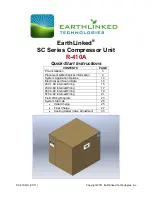
Application Engineering
B U L L E T I N
AE4-1374 R1
1/4" push-on flag type terminals, nor the terminal block
that requires ring terminals.
Deep Vacuum Operation
Copeland Scroll compressors incorporate internal low
vacuum protection and will stop pumping (unload) when
the pressure ratio exceeds approximately 10:1. There
is an audible increase in sound when the scrolls start
unloading.
CAUTION! Copeland Scroll compressors (as with
any refrigerant compressor) should never be used
to evacuate a refrigeration or air conditioning
system. The scroll compressor can be used to pump
down refrigerant in a unit as long as the pressures
remain within the operating envelope shown in Figure 7.
Prolonged operation at low suction pressures will result
in overheating of the scrolls and permanent damage to
the scroll tips, drive bearing and internal seal. See AE
24-1105 for proper system evacuation procedures.
Shell Temperature
CAUTION
Compressor top cap temperatures can be very
hot. Care must be taken to ensure that wiring or
other materials which could be damaged by these
temperatures do not come into contact with these
potentially hot areas.
Certain types of system failures, such as condenser
or evaporator fan blockage or loss of charge, may
cause the top shell and discharge line to briefly or
repeatedly reach temperatures above 350°F (177°C)
as the compressor cycles on its internal overload
protection device. Care must be taken to ensure that
wiring or other materials which could be damaged by
these temperatures do not come into contact with these
potentially hot areas.
Suction and Discharge Fittings
Copeland Scroll compressors have copper plated steel
suction and discharge fittings. These fittings are far
more rugged and less prone to leaks than copper fittings
used on other compressors. Due to the different thermal
properties of steel and copper, brazing procedures
may have to be changed from those commonly used.
See Figure 8 for assembly line and field brazing
recommendations.
System Tubing Stress
System tubing should be designed to keep tubing
stresses below 9.5 ksi (62 MPa), the endurance limit
of copper tubing. Start, stop and running (resonance)
cases should be evaluated.
© 2013 Emerson Climate Technologies, Inc.
Printed in the U.S.A.
Three Phase Scroll Compressor Electrical Phasing
Copeland Scroll compressors, like several other types
of compressors, will only compress in one rotational
direction. Direction of rotation is not an issue with
single phase compressors since they will always start
and run in the proper direction (except as described in
the section
“Brief Power Interruptions”). Three phase
compressors will rotate in either direction depending
upon phasing of the power. Since there is a 50% chance
of connecting power in such a way as to cause rotation
in the reverse direction, it is important to include
notices and instructions in appropriate locations
on the equipment to ensure that proper rotation
direction is achieved when the system is installed
and operated. Verification of proper rotation direction
is made by observing that suction pressure drops and
discharge pressure rises when the compressor is
energized. Reverse rotation will result in no pressure
differential as compared to normal values. A compressor
running in reverse will sometimes make an abnormal
sound.
There is no negative impact on durability caused by
operating three phase Copeland Scroll compressors in
the reversed direction for a short period of time (under
one hour). After several minutes of reverse operation,
the compressor
’s internal overload protector will trip
shutting off the compressor. If allowed to repeatedly
restart and run in reverse without correcting the situation,
the compressor bearings will be permanently damaged
because of oil loss to the system. All three-phase scroll
compressors are wired identically internally. As a result,
once the correct phasing is determined for a specific
system or installation, connecting properly phased
power leads to the identified compressor electrical
(Fusite
™) terminals will maintain the proper rotational
direction (see Figure 4). It should be noted that all
three phase scrolls will continue to run in reverse until
the internal overload protector opens or the phasing is
corrected.
Brief Power Interruptions
Brief power interruptions (less than ½ second) may
result in powered reverse rotation of single-phase
Copeland Scroll compressors. This occurs because
high-pressure discharge gas expands backward
through the scrolls during interruption, causing the scroll
to orbit in the reverse direction. When power is reapplied
while reverse rotation is occurring, the compressor may
continue to run in the reverse direction for some time
before the compressor
’s internal overload trips. This will
not cause any damage to the compressor, and when
the internal overload resets, the compressor will start
and run normally.
10








































